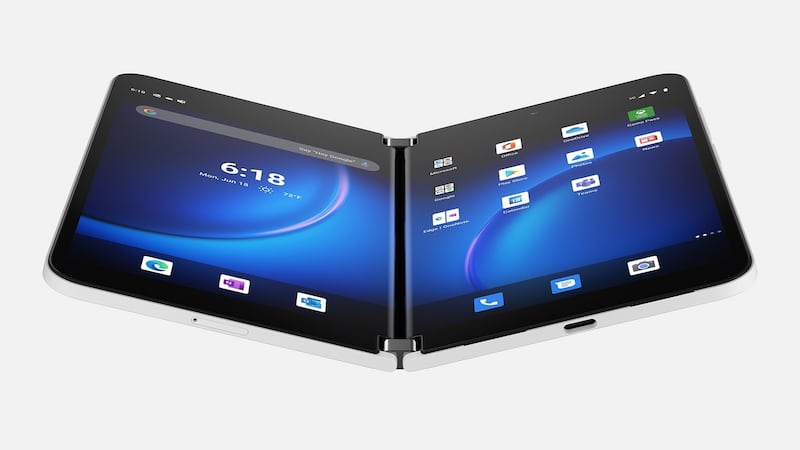Microsoft Surface Duo 2
From €1,679
Remember when Microsoft did phones? If you still associate the brand with Windows Phone, you are in for a surprise. It has been four years since the Windows Phone-powered Lumia was discontinued and the new Duo is as far away from its heritage as you could get.
The Surface Duo 2 is an Android-based, dual-screened device that acts a bit like a mobile, and a bit like a tablet, whenever you need it. It comes with Microsoft apps pre-installed, and works with accessories such as the Surface Slim pen and Microsoft Bluetooth headset.
The follow-up to the 2019 announced Duo has also made some well chosen changes to its design and hardware, making it more appealing to potential users, adding 5G support for example and NFC for contactless payments, and rounding out the edges to make it nicer to handle.
It’s not perfect, but there is much to like about the Duo 2. It is a different take on the folding phones that have sprung up on the market in recent years. Microsoft hasn’t tried to create one continuous screen. Instead, the company has gone for two displays with a tiny gap inside, so there is no fold issue. There is no outer display either, unlike its rival folding phones; if you want to know what’s going in in terms of battery charging or incoming calls, the spine of the device lights up to alert you.

Each bright AMOLED screen is 5.8in, with a 90Hz refresh rate that makes everything feel smooth, with the screen expanding to 8.3in when opened.
There are plenty of uses for that screen. Multitasking is a breeze, allowing you to have email or documents on one side and your web browser or One Drive on the other.
Documents are also easier to handle on the device; you can fold it in half like a laptop, with the keyboard on the bottom screen and the document on the top. It’s a small enough keyboard area, but if you are on the move or away from your laptop and need to fire off an email or two, it works well.
You can also have a video call on one screen and a document on the other, so all the information you need is to hand.
It does all this quite quickly. The Duo 2 is powered by a Qualcomm Snapdragon 888 processor, and comes with 8GB of Ram. Capacity starts at 128GB and maxes out at 512GB. The Duo ran most things quickly and smoothly, with only a couple of hiccups.
Where I did run into issues was trying to use the Duo 2 one-handed. It’s slightly too large for me to comfortably hold one handed and type, or at least without dropping it anyway. You can’t fold the device completely back on itself either, thanks to the camera bump on the back.
That camera bump houses a triple lens camera array, with a 12 megapixel wide angle lens, a 16 megapixel ultra wide lens, and 12 megapixel telephoto lens. The front-facing camera is a 12 megapixel lens, for clear video calls.
They all perform well, although lower light can be an issue at times, with some grainy images in poor light.
The good: The Surface Duo 2 is versatile, with sturdy hinges that stay put when you set them at a certain angle. The novelty of having a larger keyboard to send a message is a draw too, making it easy to do longer documents. It's handy to have everything at your fingertips for a video meeting rather than messing about with tabs as you talk.
The not so good: There are still a few bugs, and it can be a challenge to get to grips with apps opening on across the various screens. It's difficult to use one-handed, compared to a single screen phone. Also, this phone isn't cheap.
The rest: Accessories make the Duo 2 even more useful. The Surface Duo Pen, for example, and the Pen case that allows you to fix the pen to the phone's outer case with a strong magnet.
The case itself feels a bit less sturdy than I’d like, given the cost of the Duo 2, with bumpers protecting the Gorilla Glass on the rear of the device.
The verdict: Pricey but offers good multitasking abilities in a familiar Android package.










